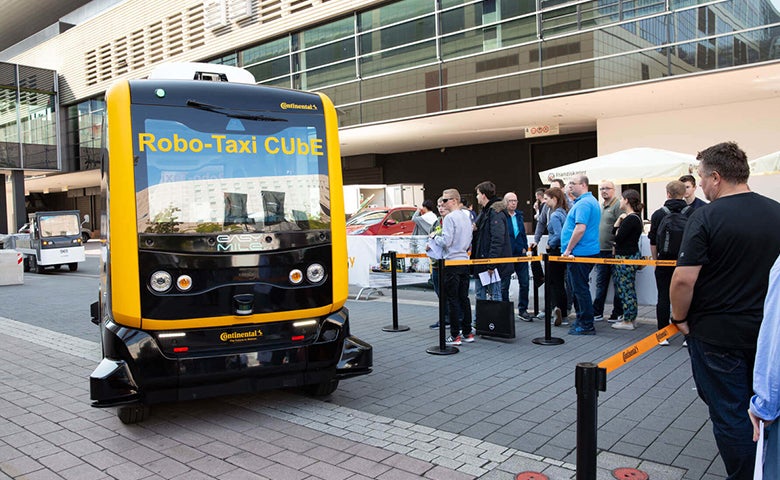
# Future mobility
Top 5 trends to watch from IAA Mobility 2021, The world's largest International Motor Show
From International Motor Show Germany to IAA Mobility

With brilliant minds consistently working on exciting innovations the future of mobility looks bright and promising. The IAA Mobility reflects this optimism, as well as the pioneer spirit currently driving the automotive industry, related research and businesses. The trade show and conference has come a long way and evolved along with the world of transportation.
For over 100 years, the International Motor Show Germany (Internationale Automobil-Ausstellung in German, hence IAA) was devoted almost exclusively to automobiles. The original IAA auto show was originally held in Berlin, more recently in Frankfurt. This year, it hasn’t just changed its name to IAA Mobility, it is also taking place in Munich for the first time.
With the motto “What will move us next,” the conference focuses on green mobility in a one-of-a-kind decentralized event where all the mobility-related technological advancements are highlighted and celebrated. In keeping with this realignment, a majority of the speakers, exhibitors, and open spaces will be focused on eco-friendly mobility of the future.
Here are 5 innovations we are most excited to find out more about.

thousand visitors
(2019)
561

thousand journalists from 95 countries
(2019)
8

Speakers from 25 countries
(2019)
227
The IAA 2021 trends in 40 seconds
IAA Trend I: Automation
Automated driving has been trending in one way or another ever since science fiction writers first imagined autonomous vehicles almost 100 years ago. So what’s different this year? For starters, self-driving cars already exist and are successfully being tested all over the world. More importantly, acceptance is reaching a tipping point. A recent Continental Mobility Study showed that driver assistance systems and autonomous driving are gaining acceptance worldwide.

The IAA mobility will showcase related topics like the computer brains needed to process all the data for safe autonomous driving, the changes self-driving will bring to car interiors and the ensuing effects on infrastructure. However, the show will also focus on automation on a smaller scale, for example Automated Valet Parking, which allows drivers to park their cars through their smartphone.
IAA Trend II: Connectivity
Of course, automation is impossible without connectivity – and the latter is already deeply woven into the fabric of our everyday lives, on and off the road. Cars can already be unlocked remotely without touching a button and connect to the IoT (Internet of Things), they receive over-the-air software updates and route planning is automatically adjusted according to the current traffic status. In the immediate future, smart voice assistants will connecting car and home, the evolution of vehicle sensor systems will increase traffic safety, especially for vulnerable road users and cars will communicate with each other in flowing traffic.

A car communicating with a traffic light to determine the situation at the intersection might still sound futuristic idea, but intersections are already. Connected cities won’t just improve safety and quality of life for all traffic participants, digital technology will also make sustainable transport more efficient.
IAA Trend III: Fast Charging
It goes without saying that electric mobility has been and will continue to be the determining trend, on two and four wheels, all over the world. There is no doubt that e-cars are going to become the norm, but the questions are in the details. Next-generation batteries, such as the new scooter power pack developed by Continental and Varta, will provide longer ranges at a lower weight, as well as a longer lifespan.

However, more convenient and widespread charging options will be key to acceptance, especially outside urban areas. Potential solutions include tapping into existing infrastructure like lamp posts or internet distribution boxes, charging robots or inductive charging. With new chargers on the market, hours-long charging stops will become a thing of the past. 350 kW chargers can charge an electric car for a significant journey (150–250 km) in only 20 minutes. That’s just enough time to get a coffee and stretch your legs before getting back on the road. However, e-mobility isn’t just about efficiency and sustainability – the world’s fastest electric cars will also be on show at IAA Mobility.
IAA Trend IV: Sustainable Urban Mobility
For the first time ever, the IAA show will shed a light on all forms of mobility, including micromobility, innovative public transportation, smart infrastructure, and more. Some of the hottest mobility start-ups and representatives of the sharing economy and ride-hailing businesses will be in attendance to pose the question, “how do we want to move through the city of the future?” With the number of cars on the road growing each year, compactness is becoming more and more relevant.

New achievements in micromobility that will be introduced at the IAA show include emission-free e-scooters, bicycles (both next-generation human-powered pushbikes and e-bikes), mopeds, velomobiles, and micro cars. If you need a break from all the advancements on the road, you can also explore new technologies in the air mobility industry, such as vertical take-off and landing, or VTOL, aircraft. With the promise of speed, ease, and zero emissions these air taxis are hoping to become the go-to mode of transportation for short to medium distances.
IAA Trend V: Sustainability
The “digital and climate-neutral mobility of the future” is the overarching theme of this year’s IAA Mobility, so sustainability is somehow connected to almost every trend listed here. Autonomous and connected vehicles will be more efficient, which will save fuel or power, electrification will reduce emissions and sustainable urban mobility concepts will reduce the reliance of city-dwellers on individual transport. However, there are many other conversations surrounding sustainability in future mobility to be had. E-fuels, fully electric ferries and trucks, hydrogen-powered transport and emission-free flying are all on the agenda.

